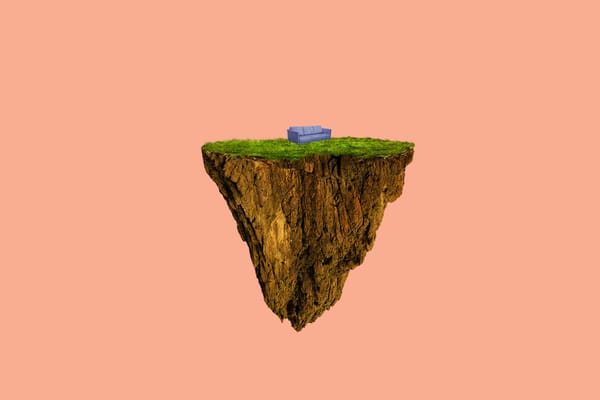Please, sir, I want less
Plus: Asta loséS a sponsor, our own personal Ben Kadows, two griptape brands get stuck together, a swamp thing, and more.

The definitive weekly ranking and analysis of all the skateboarding and other things online that I cannot stop consuming and how it makes me feel, personally.

Please, sir, I want some more less
Rank: ugh
Mood: 🤲
At some point, the job requirements for a professional skateboarder became both more opaque and demanding. In the halcyon pre-social media days, the general responsibilities of the sponsored skater were, more or less, to get the occasional photo in a magazine, produce a video part every other year, and go on tour if budgets allowed. This framework was elastic, mind you. Some skateboarders made entire careers out of two video parts and an air of mystery. These standards, if you want to call it that, meant it was much easier to loaf around and stagnate as a professional athlete — which most didn't see themselves as at the time. However, the purpose of the arrangement was clear: it was a skater's "brand" that added perceived value to the company and was what the company paid them for.
This was before having a "personal brand" was openly talked about and vigorously cultivated. The gauge was, in essence, whether or not a person was "cool" or "good" and had the highest potential of pushing product to kids. Since the advent of social media, the idea of what value a skateboarder provides a sponsor has been in flux.
It's no secret that companies value athletes with big online followings, as each follower is a potential vector for exposure to a sponsor's product placements. Some skateboarders primarily post on Instagram for this very reason — the impact and results are immediate. A sponsor can see just how many likes, views, and comments — and, in some cases, purchase conversions — an athlete's promotional posts receive. There is a whole array of engagement metrics to cite that may or may not mean anything at all.
While trends on the social web ebb and flow and "traditional" means of coverage (video parts, photos in magazines) remain relatively important, the one constant borne out of our current era is the demand for constant production. Ever-present visibility. Continuous content to feed the feed because if we can't see you, we might forget you. Many professional skateboarders release multiple video parts a year and post countless Instagrammable clips, while others have also turned to platforms like YouTube to supplement their audience and connect with them on a different level. Cumulatively, it's an unthinkable level of exposure compared to a pro skater from 2006.

These are all things I've said in some way or another in this newsletter before, but there's a follow-up we don't have a great understanding of yet: is any of it working? As the skateboarding industry continues to atrophy and more acquisitions and bizarre licencing agreements litter the landscape, prospects don't look great for the professional skateboarder class. In May of last year, Sole Technology sold Etnies, Emerica, and éS to the Nidecker Group — a Swiss snowboarding brand conglomerate — and in recent weeks, there have been several high-profile departures at those brands, with Etnies riders Chris Joslin and Aurélien Giraud being at the fore.
Joslin has over a million followers on Instagram. He's an Olympic-level athlete who still produces astoundingly impressive video parts. Giraud ticks most of those boxes, as well. They are very clearly doing their jobs and doing them well, but it's still not enough. Of course, brands are allowed to change direction, and perhaps Etnies wants to appeal to more of a "core" audience, which Joslin and Giraud could be considered outside of. Or it could be as simple as the duo being big names and carrying big(ger) contracts, making them prime targets for cost-cutting. Whatever it is, in the end, the value they'd worked so hard to develop for a brand became muddled, a burden, up for reinterpretation.
As former éS rider Tom Asta explained in a YouTube video uploaded to his channel on Sunday, his wasn't even up for discussion. Late last year, when he learned from éS team manager Kelly Hart that his contract wasn't being renewed, he was told that the new management didn't see the "value" in what he did despite riding for the brand for a decade and working diligently to film video parts and develop a seemingly successful following on YouTube and other platforms, all things they had previously been supportive of and encouraged.
Asta is reasoned in his response to his dismissal but is clearly (and rightfully) surprised that there wasn't an opportunity to speak to the Nideckers at all, never mind negotiate. He was even willing to take a pay cut — after he'd already accepted a settlement to receive just a portion of what was owed to him on royalties with the previous owners. It's hard not to see this as illustrative of the state things are in. Professional skateboarders do more than ever before and can't even get in the room to make their case for getting paid less.

An original
Rank: 1
Mood: 🌶️
The narrative crux of Ben Kadow's Epicly Later'd episode is that he's an unusual guy. That he does things differently from the rest. He dresses differently (funny), he acts differently (crushing anxiety), and his lived experience is different (he's held a job outside of professional skateboarding). This, Bill Strobeck proclaims in talking head form, makes him "an American original."
There is something to that. However, American exceptionalism has nothing to do with it. Clothes, anxiety disorders, and jobs exist everywhere. As a viewer, what is most appealing about Kadow is his undercurrent of intensity. What we're shown of it on screen and in the pages of what magazines remain feels authentic. He is also very good at skateboarding and does interesting things on his skateboard, but the intensity of his personality truly guides it.
That's what makes him unique in the contemporary landscape of professional skateboarding, where everyone is an exceptional talent and so much of what we see often blurs together. You expect Tiago Lemos to do a switch-kickflip-backside-tailslide because he's an incredible technical skateboarder. You expect Ben Kadow to attempt to tail drop from a balcony railing onto a handrail and eat tremendous shit, not just because he's someone who does that type of skateboarding, but because he's got the personality of a skateboarder who would.
To paraphrase a quote about Emile Laurent, whose origins I cannot remember for the life of me (media outlets, Twitter, SLAP, group chats — apologies to all), he's "like if your local skatepark hero got good." That's the energy Kadow brings. It's not that he's so different but that he's so familiar. Most of us have had a version of this character in our lives. That one local with a single shaved eyebrow wearing a blank t-shirt with "Space Jam" Sharpied on who does nosegrabs off the top of an eight-foot quarterpipe to flat. Skateboarders more concerned with attempting the most ludicrous trick their imagination and body will allow in whatever 15-yard radius they're currently in than who the latest addition to the ASICS roster may be.
Those beautiful, confounding souls are everywhere. They're not American originals but skateboarding originals. Protect them at all costs.

Grit, determination, merger
Rank: 2
Mood: 🧻🧻

When two companies that trade in adhesive-backed products combine, you've got a real sticky situation on your hands. No? Nothing. Whatever, that's fine.
Is there anything else to say about Shake Junt apparently merging with Mob Grip? It does leave one wondering a few things, though. Will Shake Junt be distributed by NHS, which produces Mob? Will they now use the same manufacturer if they didn't already? (Ben Woody, VP of Product at NHS, told Claire Alleaume in a Jenkem piece from 2020 that "basically all the smaller brands come from the same place.") Is there a chance that the Shake Junt grip formula will change? I reached out to NHS for comment on the above but did not hear back by the time of publication.
This also begs other important questions: does this consolidation speak to the increasingly dire straits the skateboarding industry appears to be in, that even a relatively small operation like Shake Junt needs a hand to survive? And most importantly, chickenbonenowison?

A change in priorities
Rank: 1
Mood: 🤳❌/📹✔️
What does it tell us, us being "skateboarding" or the loose configuration of commercial nodes that comprise the "skateboarding industry," that 48-year-old Guy Mariano's iPhone clips filmed from 2022-2024 and released as a compilation by his clothing sponsor Dickies on January 1, is a far better and more entertaining effort than his brief section in Dickie's full-length feature Honeymoon?
In the clip compilation, Mariano does some legitimately shocking maneuvers that he may have even been the first person on this planet to accomplish. Frontside-270-boardslide-to-crook? Okay! What about that gigantic switch-frontside-shove-it on the brick quarterpipe — how does a person nearly a half-century old still have it like that? Amazing. Beautiful. His part in Honeymoon pales in comparison.
Perhaps it tells us that Mariano is of a different status, that he can focus his energies elsewhere, like cruising around Los Angeles with Stefan Janoski filming skateboarding tricks with a selfie stick. It certainly implies to those at home that he preferred doing so, which is conjecture, sure, but it's what the evidence suggests. It's also interesting that Dickies released the compilation and not his other sponsors like Nike SB or April Skateboards, this perhaps seen as backfill content.
Whatever the case, I end with a plea. Not of Mariano or Dickies or an industry whose trends wobble and waver with a sick glee, but of Janoski. Bro, imagine if you filmed all of this stuff on a VX? Consider it for 2025-2027, please.

Ye monster of little depth
Rank: -2025
Mood: 🧌
Over the holidays, I gourged myself on the collected volumes of Alan Moore's Swamp Thing. Decades late to the game, I found it as praised: a stunning, "sophisticated" work whose influence remains apparent across the medium and genre today. While sometimes dated, the stories within and the cultural commentary they're built upon are still compelling, insightful, trenchant, and brought to life in superb fashion by the pen and colour of Stephen Bisstte and John Totlenben. Moore's writing is tight and instructive but not overly hand-holding. It's full of fun flourishes and genuinely moving prose. He describes an anxious corpse with a particular tenderness.
"When sleep won't come, what notions do they entertain in those frail parchment bulbs that were once skulls?"
From rhyming demons and spectral wanderers to underwater vampires, werewolves, zombies, and the like, Moore infuses them with more than tropes. There's no easy moralizing or simple conclusions. He makes monsters interesting.
As 2025 continues on with the horrors that preceded it, Swamp Thing is a stark reminder of how utterly uninspired our monsters are. Whether that's tech companies capitulating in advance to authoritarianism, governments that prioritize lobbyist interests over the desperate cries of their citizens and a planet on fire, or world leaders' bald acceptance and support of civilizational destruction and genocide — these are such flat caricatures of evil that they'd be cut from most works of fiction for having no depth.
The underwater vampires were at least trying to create a community for themselves. The only drivers of our societal monsters are greed and hate. The frail parchment of their skulls is filled with nothing. No empathy, wonder, or reverence, just a void demanding more.
Anyhow, look at this guy. How can you not love him?


Something to consider: Destroyer goes to A&W.
Good thing: Paul O'Connor, Brian Glenney, and Max Boutin are back with another academic heater, "The skater’s ear: a sensuous complexity of skateboarding sound."
The sound of skateboarding is an issue fraught in controversy: the sound is a common basis for public noise complaints as well as participant praises. We consider a possible basis for this controversy, an inherent subjectivity of skatesound, one that is truly in the ‘ear’ of the beholder. This paper centres subjectivity in the sensory lives of a group of 18 adult skateboarders. These interviews provide rich qualitative data on the sonic spectrums of skateboarding, including how skateboarders describe skatesounds as both unpleasant and lovely, and the importance of adding music and the annoyance at headphone use while skateboarding.
Another good thing:

A good Tyler Surrey quote:
It’s good to dive into yourself and see what kind of person you are as an individual. Skating is one of those things that has no formula. It’s a very subjective individual process. You have to find parallels between your own personality and skating and what works for you. This sounds dumb, but it’s kind of like a synesthesia process. You can put feelings to different thoughts and overlap your physical experiences with your senses and feelings. It’s not a direct “you can taste colors” thing, but relating your personality to skating. It’s really hard to put into words.
A long, fascinating, frustrating, byzantine business thing:

And a good pull quote:
Wu and Huang seem to have had a good grip on a grim truth of modern capitalism: You do not become rich by selling things to consumers. You become rich by selling projects to investors.
A those guys from Winnipeg are good thing:
A good re-share: This post about a late '90s zine in Natalie Porter's Womxn's Skate History from September.

A good selfie:

Until next week… if you happen to suffer a life-changing incident and your consciousness gets absorbed by a burbling swamp, turning you into an immortal earth elemental who can tap into all the power and wonder of this planet, know this: you can still go out on dates and stuff. People might think it's weird that you're dating humans, but don't let them yuck your yum (love).



Laser Quit Smoking Massage
NEWEST PRESS
--------------------------------
My new collection of essays is available now. I think you might like it. The Edmonton Journal thinks it's a "local book set to make a mark in 2024." The CBC called it "quirky yet insightful." lol.
Book cover by Hiller Goodspeed.

Right, Down + Circle
ECW PRESS
--------------------------------
I wrote a book about the history and cultural impact of Tony Hawk’s Pro Skater that you can find at your local bookshop or order online now. I think you might like this one, too.
Here’s what Michael Christie, Giller Prize-nominated author of the novels Greenwood and If I Fall, If I Die, had to say about the thing.
“With incisive and heartfelt writing, Cole Nowicki unlocks the source code of the massively influential cultural phenomenon that is Tony Hawk’s Pro Skater, and finds wonderful Easter-eggs of meaning within. Even non-skaters will be wowed by this examination of youth, community, risk, and authenticity and gain a new appreciation of skateboarding’s massive influence upon our larger culture. This is my new favorite book about skateboarding, which isn’t really about skateboarding — it’s about everything.”
Photo via The Palomino.










